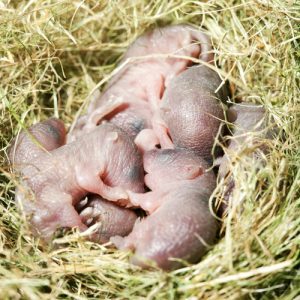Could You Recognize a Mouse Nest?
By Chris Williams on August 29, 2012.
Question
What does a mouse nest look like? I think I found one behind my stove.
Answer
The quick answer is that a house mouse nest is a loose mass of various collected soft materials, and is usually about the size of a grapefruit. The pregnant female mouse gathers a variety of materials, working with what she has at hand and sometimes showing great creativity in what she collects. Her goal is to make a soft, warm cushioned place for her hairless newborns to safely nurse and grow.
Mom mouse will collect soft materials that she encounters in her travels and will shred or create soft materials if she has to. She will make as many as 150 foraging trips in a single night to collect nest material. These are some typical items that you would find making up a mouse’s indoor nest: pillow or furniture stuffing, carpet fibers, feathers, plastic, bits of fabric, shredded paper, paper towels, toilet paper or tissues, dryer lint, cotton balls, bits of string, and grasses and leaves if available. Depending on the material collected and the nest space available, the end result can be a ball that encloses the mouse or simply a platform of loose materials.
 A friend once dug some laundry out of the bottom of a basket in her laundry room (she admitted that the clothes had been sitting there for some time) only to find some good-sized holes in her T-shirts where a mouse had helped herself to some fabric. This need for soft nesting material is why some pest control technicians bait their mouse traps with bits of cotton or fabric instead of food. If food is plentiful, the female mouse is more likely to be attracted by nest material.
A friend once dug some laundry out of the bottom of a basket in her laundry room (she admitted that the clothes had been sitting there for some time) only to find some good-sized holes in her T-shirts where a mouse had helped herself to some fabric. This need for soft nesting material is why some pest control technicians bait their mouse traps with bits of cotton or fabric instead of food. If food is plentiful, the female mouse is more likely to be attracted by nest material.
Another clue that you’re looking at a mouse nest is that it will contain mouse fecal droppings, or you may find small piles of droppings near by. Mouse droppings are usually black, rod-shaped, about 1/4 inch long and pointed at both ends. Fresh droppings are shiny black and soft like putty; older droppings are dull and brittle and crumble if squeezed. You can also find bits of hoarded food (like seeds or dry pet food) in the nest.
Where do you find the nests? House mice nest in hidden, dark places that are near a food source. Mice rarely travel more than 30 feet to get from their nest to food. That’s why the number one location for mouse nests in a home is somewhere in or very near to the kitchen. Behind the stove is a common place for mice to nest. You can also find mouse nests in the back corners of lower kitchen cabinets, behind cabinet kick plates or in wall voids, in and under stove pan drawers, and in warm places near electrical motors like under or behind dishwashers or refrigerators. Besides kitchens, you can also find mouse nests in pantries, back corners of closets or drawers, inside stuffed furniture, in boxes, in attics (where the kitchen may be only 12 feet below), or in garages (especially if pet food is nearby).
If you think you’ve got mice, give Colonial a call. Our technicians will do a thorough inspection, looking for evidence of mice and looking for openings where mice can get in. We can seal those openings for you and can set up a trapping or baiting program to eliminate any mice already inside your home. We do pests so you don’t have to!